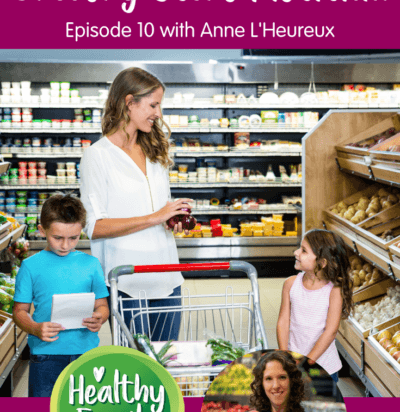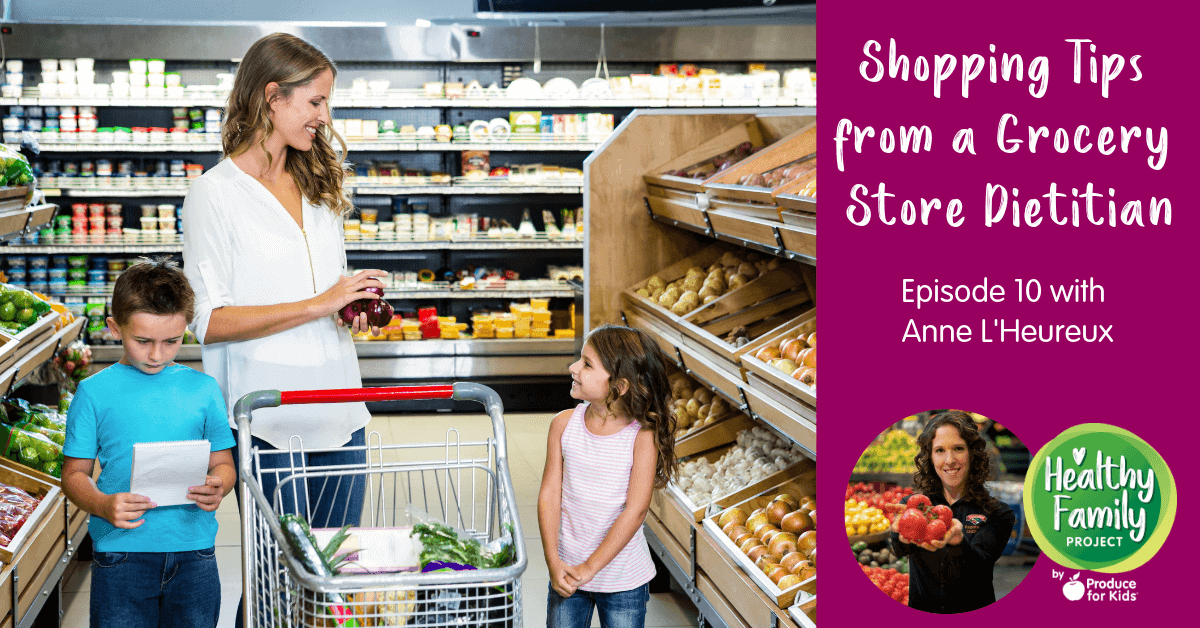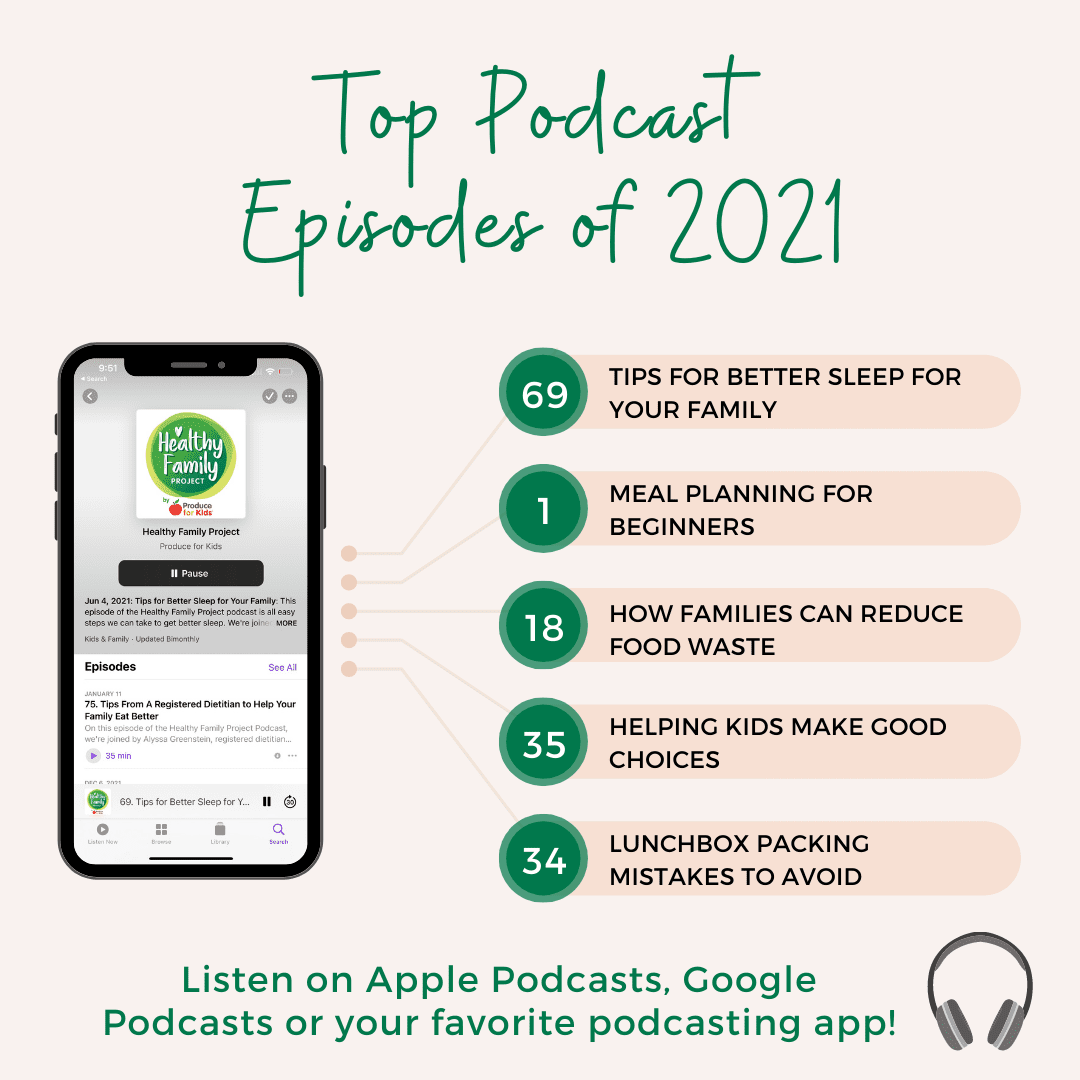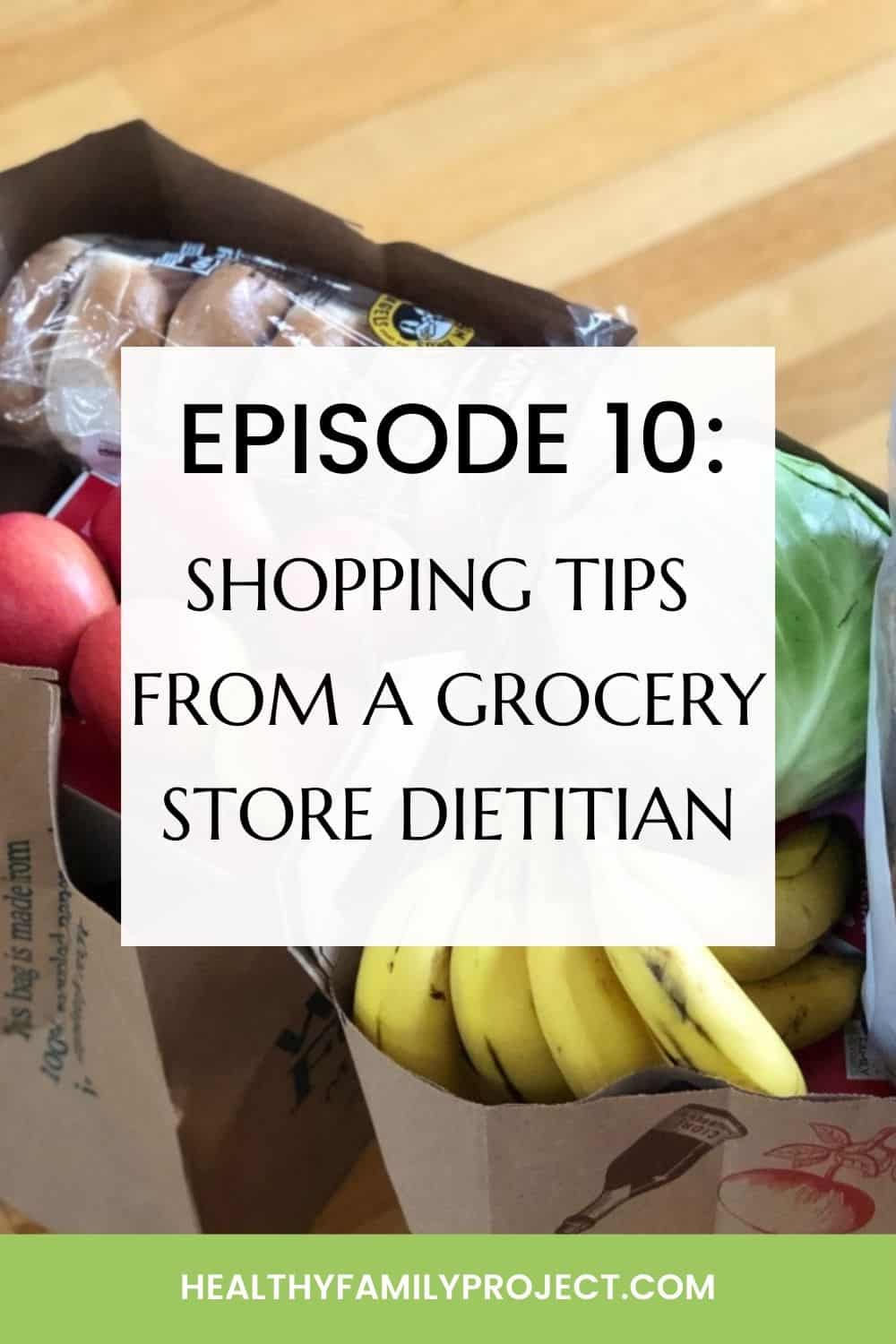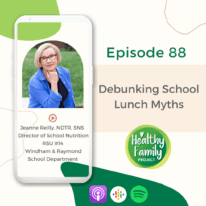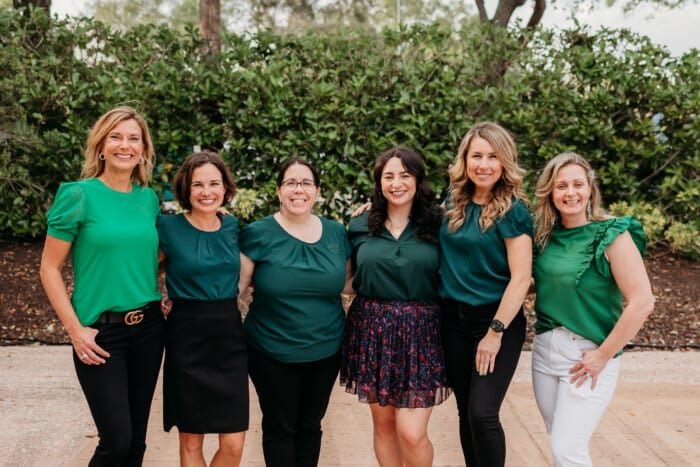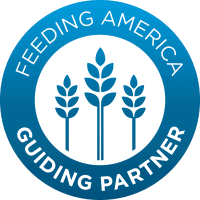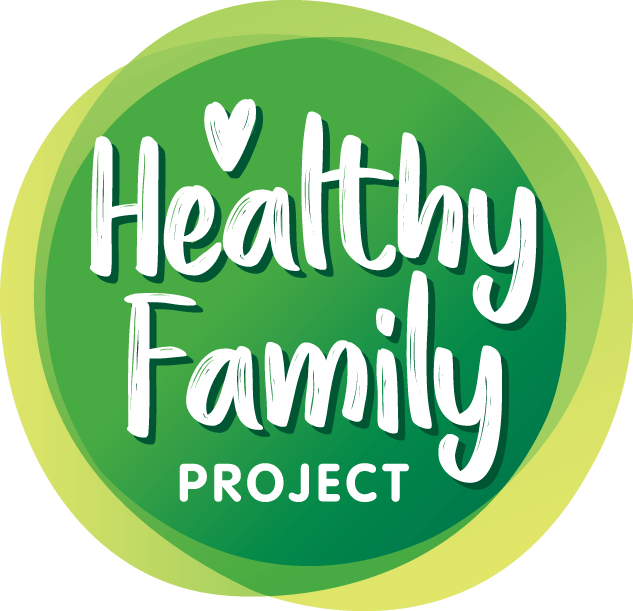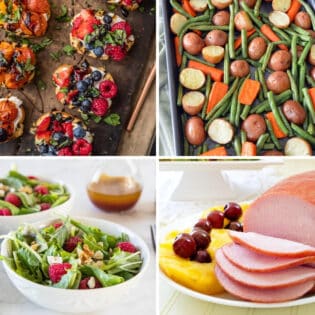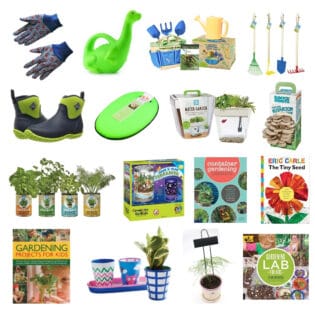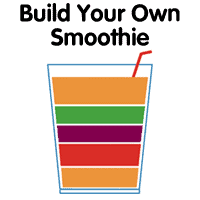Episode 10: Shopping Tips from a Grocery Store Dietitian
In Episode 10: Shopping Tips from a Grocery Store Dietitian, we sat down with Anne L’Heureux, corporate registered dietitian of Hannaford, to talk all about grocery store dietitians.
You might be wondering, “what is a grocery store dietitian and how can they help my family?” Well, that’s what we are here to talk about! Your current grocery store might offer free nutrition services you didn’t even know about. How great is that?
About our Grocery Store Dietitian
Anne earned her BS from the University of Medicine & Dentistry in Newark, New Jersey. Anne has been a dietitian with Hannaford since 2015, beginning her Hannaford career in the Kennebunk and Biddeford, Maine, retail stores.
Eating healthy can be challenging at times especially with all the new products and so many different choices at the grocery stores. And when the kids come along, it can be even more challenging to pick healthier choices. The pre-packaged stuff and quick grab and go snacks are on every corner.
As a dietitian, Anne strives to help customers navigate the large and sometimes confusing world of nutrition. If you want to learn more, make sure to listen to the entire episode and stop on back to let us know how this podcast has helped you!
Listener Survey!
Thank you so much for supporting the Healthy Family Project Podcast! We’d love it if you could take 5 minutes to let us know how we can bring you the best possible content for future episodes. Take the survey here.
Healthy Recipes & Tips in Your Inbox
Sign up for the Healthy Family Project e-newsletter to receive healthy recipe inspiration, our latest blog posts and more directly to your inbox each week.
Healthy Family Project Facebook Group
Join our Healthy Family Project Facebook group! This group will serve as a safe space for parents and caregivers to talk all about raising a healthy family – from dealing with a picky eater and tips to get more fruits and veggies onto plates to exercising as a family and mental health. We welcome all of you to join in!
Listen to Episode 10: Shopping Tips from a Grocery Store Dietitian
Want to skip straight to a hot topic? See time stamps below. But of course, we recommend listening all the way through!
- 2:54 Meet Anne
- 7:50 How the Hannaford Dietitian Program helps families
- 15:50 How to find if your grocery store has a registered dietitian
- 19:22 Hannaford guiding stars program
- 24:45 Advice for families trying to shop healthier for the new school year
- 27:30 How to involve kids in the kitchen and encourage healthier habits
- 34:10 Trends in child nutrition
Relevant Links:
- Hannaford Dietitians website
- Guiding Stars
- Grocery Shopping on a Budget
- 6 Tips for Saving Money in the Produce Department
- Lunchbox Ideas
- BLT Bento Box
Healthy Family Project Podcast
Conversations covering hot topics in the world of health, food and family with a dose of fun. Helping families ease their way into a new fresh and healthy world.
Be on the lookout for new bi-weekly episodes and don’t forget to subscribe on Apple Podcasts, Google Podcasts, Spotify or your favorite podcasting site. If you like an episode, make sure to leave a rating and comment.
If you are interested in being a guest on the Healthy Family Project podcast, contact amanda@healthyfamilyproject.com with your topic idea for consideration.
Make sure to Pin It!
Transcript for Episode 10
This transcript was produced by Otter.Ai. Please forgive any misspellings and grammatical errors.
00:13
Welcome to the healthy family project by produce for kids covering the hot topics in the world of health,
food and family with a dose of fun. Well, today’s a big day we are celebrating episode 10 in the healthy
family projects first season. This time last year as I was sifting through all of the useful content we have
on produce for kids.com, I realized there had to be another way to bring this content to life for busy
families. And the podcast world seems to be that place. So we are loving, sharing with you and having
conversations about tough topics that we all face, and finding resolutions for those. So today we are
talking to a retail dietitian. And a lot of you might be wondering, what is a retail dietitian? That’s a kind of
a fancy word, I guess, if you will. And really how can can this person help my family. And so that’s exactly
what we want to talk about today. So your grocery store may offer some of these services and they may
even be free. You know the nutrition services. So today we’re going to talk to an LE Roo, who is a
corporate dietitian at Hannaford Supermarkets. Hannaford Supermarkets have been around the block a
few times, starting, as you guessed it, a fresh produce vendor in Portland, Maine, way back in 1883.
That’s a really long time ago. And now the grocer has 181 stores from Maine to New York. So some of
our listeners may be shoppers shoppers at Hannaford. So in formerly worked in actual stores where
shoppers were looking for assistance, so she worked one on one with shoppers, but has since moved
into the role of a corporate dietitian, and is a part of a team of 34 dieticians, located throughout 61 of the
Hannaford locations. In works in a variety of settings in in addition to Hannaford. She consults in long
term care and assisted living facilities, sees clients from all over the US through online coaching and
writes for a national obstacle racing company on the topic of nutrition and fueling athletic performance.
She loves the variety that her job provides and feels as though they keep her nimble on a variety of
nutrition topics for all ages and walks of life. So without further ado, let’s get on with Anne and get the
inside scoop. Welcome and we are really excited to talk to you today and get the scoop on how grocery
store dieticians can help families. Yeah,
02:53
thank you for having me very excited to be able to share that Hannaford dietitian story.
02:57
Wonderful. So before we get started, I always like to ask our guests what inspired them to venture into
their current field or project I really think it helps us understand the personal side of who we are talking
with.
03:12
So for me, it really stemmed from a selfish area in that it was intriguing to me learning more in the field of
nutrition I grew up you know, a really inactive overweight child in my household My parents really
showed a lot of love through food we didn’t have a whole lot and so that was one of the areas that were
things that we could afford. And so that was kind of their way of showing us love and keeping us happy
and of course some of the easiest to access foods aren’t always the best ones so there wasn’t a whole
lot of homemade and I mean my parents were great but there was a lot of it was during a time when
there was a lot of that really new exciting to me anyways food coming up and you know things like
different fast food restaurants and everything like that, so need to TV dinners all the way. Yeah, you
know, and so unfortunately I grew up loving those items and then I finally realized I went in the Navy until
things changed a little bit there I started to understand how food and activity really how they made me
feel in a positive way and I wanted to keep that going and after I got out of the service I had money for
college at that point so I started looking into different career paths and that’s when I came across the
field of nutrition and dietetics and not even realizing that was a field before so got that got me really
excited and once I started learning just the the excitement and the passion for it really just never went
away. And to this day, it’s such an ever changing world that it’s something something new every every
week.
04:49
Well that’s wonderful. I feel like it’s so magical, I guess is the word that if you can find a field that he
where you have that passion and you have that life experience that has led you to do what you do. And
it’s really interesting that you said that you realize how you felt, because I think that that is important for
families to understand that once you make some changes, and you see how you feel you have that extra
energy, you have that extra bounce in your step you have, you know, you’re not tired, then it’s, it makes
so much sense. You know, from that family standpoint, like, Hey, look at this, we’re doing all of these
things, we feel great. Let’s make that change and stick with it.
05:38
Yeah, and I think that’s the the piece is that the people that are able to stick with it are the ones that, that
stick with it long enough to that their body can reap those benefits. And I feel like it takes you know, two
to four weeks of consistency before you really start to feel the changes. And once you feel that you just
don’t want to give it up. I think we all have heard enough and inherently know to eat the good foods. But
once you feel that feeling. And what’s interesting is the more of those good foods that you take in, the
more you are aware when you do decide to have something else that maybe you would have previously
had to go out to that fast food place, how much instantly you can feel the negative effects from that. And
that’s not to say that, that’s not to say that I’m not perfect, and I definitely I have I do enjoy sweets, and I
like to have those but when I have them, I definitely feel differently. Whereas before my body was so
used to it that I didn’t even I didn’t, I wasn’t aware that there was a difference just because like I said, my
body, it was used to getting that sort of thing. So when I wouldn’t have I don’t think I would have even if
somebody was trying to tell me years ago, I wouldn’t have been able to understand what they meant
when you say when they said you feel differently. I had it was something I had to experience it
experienced myself. And I think like I said once people experience that for themselves, it finally clicks
like, oh, I can feel like this. This is great.
07:03
It definitely is I know my older daughter, you know, I I’m kind of letting her guide herself. Let her stomach
tell her you know, I give her the the tools but you know, she’s testing the waters and and she definitely
will say to me, Wow, you know, that looked really good. And it tasted really good. But I don’t feel so good.
I’m like, yeah, yes, this is you know, this is your body talking to you. And you got to listen to it. And so just
getting through those two to four weeks, so I know can be hard, but we all know the answer and and
pushing through and feeling great is is the goal so well. So I think we should kick this off with a little bit
about Hannaford stores and the support that your dietician team provides to families.
07:50
Yeah, so Hannaford has a really excellent and now robust dietician, program, we’re, you know, we’re 34
dietitians in 61 stores all over, you know, five states, Maine, New Hampshire, Massachusetts, Vermont,
and New York. And the goal of the program is to really help families, you know, not just families,
individuals, finding creative ways to do so many things with food, we know that shoppers are just as
curious as we are about nutrition, but they may be a little bit more confused. So we’re there to, you know,
help guide them through some of those confusing nutrition. I call it like information overload with nutrition
these days, you just everywhere you turn, there’s something different, you don’t know, it’s confusing,
right? You don’t know what’s right anymore. And you don’t want to feel like you’re doing something
wrong. So we’re able to, you know, anytime in the store, our customer might just be walking through and
they see us and they’re say, Hey, I heard this on the news this morning. Can you tell me a little bit about
that. And we work to really try to help people navigate through what they heard, and why that may or
may not be appropriate for them. And then if it is, we can go directly at that time to the aisle or wherever
it is, and say, Hey, here’s a couple examples of some foods that would help you incorporate that. And so
it really gives us the perfect platform, right in the store that this is where the person does their groceries
anyways. So they’re used to being in there they used to what they buy, so we can just help guide them
to, you know, perhaps there’s one thing that we can swap out to take them down their path. So we also
do weekly demonstration recipes. So every week is a different topic. We try to keep it relevant, we try to
keep it ever changing. So 52 weeks out of the year, there’s 52 different topics. And so each week we
have a different theme, with different handouts that help keep it simple and explain it really, really well
and in ways you can put it into us and then we also have a few recipes, including one demonstration
recipe that we go through so you’re able to not only learn what the topic is, but then you’re able to see
ingredients that help support that. And then you could even taste the recipe before you decide whether
or not you want to go home and try it. So, you know, so there’s those pieces, we do free classes, student
classes and store chores either for groups like Boy Scouts, we’ll do it for local doctors, offices, anybody
we can connect with really to say, Hey, what is your service in the community? What group of people do
you have? And how can we get that group in the store and we can help guide a tour around anything that
you guys are are learning, you know, we’ve had local weight watcher groups come in, we’ve had cancer
survivor groups come in, and we do a lot with just, you know, kids cooking and things like that. So, but
really any topic that you can think of our dieticians have either already covered it and are going to again,
or we’d love to create a personalized group just around whatever you need.
10:57
That’s wonderful. And I think what maybe sometimes people don’t realize at your stores is that these
services are are free, correct there’s
11:06
free absolutely, that the program is primarily funded by sponsors of some really great companies you
know, such as fresh express fallow kits, we have Cabot which, which gives us some really good you
know, Greek yogurt and some reduced fat cheeses, and cedars with hummus, we have SmartWater
Zico, so we have a whole variety of sponsors that are nutritionally we’ve overlooked them. And we said,
yes, we want to support them, and they want to support us. So that really allows us the opportunity to be
in the store, and providing the services like you said, for for free to customers, which can be huge, you
know, you go to the doctor’s office, you pay for that visit. And that’s already at a pocket so we can pick up
for free, and take whatever you were told in the doctor’s office, and you come in, and we can help you
carry that out. So we’re kind of that continuum of, of care. So yeah, it’s really great to be part of a
program that can provide the free services.
12:06
Well, that’s wonderful. It’s the perfect circle, because as you said, there’s a lot of confusion. And I think
your doctor will say, you know, here’s the deal, here’s what the you know, diagnosis or what’s going to be
coming down the pike if you don’t make some changes. And so when they leave that doctor’s office, I
think oftentimes, you just don’t know what where to go, or this lifestyle change or even like you said, the
confusion of every morning on TV, it’s something different, like peanut butter is bad. No, peanut butter is
good. Oh, don’t drink coffee. Oh, drink five cups of coffee. It’s like, right.
12:42
Right. Right, right. And even if we think about like, I mean, the stress of have a, have a mom or a dad in
a pediatric office who is trying to figure out, you know, maybe they’re going in, and they’re working with
something with their child, and they’re told, you know, okay, that your child needs more protein, or they
need more calcium and you know, have to work on their immune system. And, you know, they’re already
maybe scared or just exhausted from whatever’s going on. And then they hear these things in the office.
And it all makes sense, but then they know, their child might be a picky eater, or they know that, you
know, funds are limited or whatnot. So what can they do, and that’s where they can come into the store,
and we’re able to say, hey, we can help you shop healthy on a budget, we can help you, you know, show
ways to sneak different veggies into your child. And we can find different proteins that even maybe your
child is, you know, maybe your family is vegan or vegetarian, we can help make sure that they’re getting
in the protein they need, but also the other vitamins and minerals that they may be missing from not
having those animal products, we can definitely help get a well rounded nutrition approach in no matter
what that is so
13:48
awesome. Well, and I will just just so listeners know in the show notes, I will link up to you know where
you can get more information. If you are in a Hannaford store area, and you have a group that you you
know, want to reach out or need more information in the shownotes, we’ll have links, so you can easily
access all of that.
14:08
Yeah, and the website link that you’ll have in there is great because you can actually go on the Healthy
Eating tab and you can really, they make searching and finding your dietician really easy because it’s
listed out by stone associated by state and then you click on your state, it’ll pick up all it’ll bring to you to
a section where all of the Hannaford stores within that state that have a dietician, and then it’ll show you
the list and you can click on it if your store is there, and it’ll take you right to their current schedule, with
their email and everything. So that’s awesome and and no worries either. Because on that web page,
you’ll also see that if your store doesn’t have a dietician, it gives you the contact information to reach out
to me as the online dietitian. So that’s really helpful just in case you happen to be in an area that doesn’t
have a Hannaford dietitian in the store just yet.
14:55
Great. Well, user friendly. I like that.
14:58
Gotta be yeah Well, awesome.
15:00
So your team is busy helping shoppers. But we do have podcast listeners all over the world at this point,
which is crazy to me. You know, I’m here in Orlando. And when I look at weekly, I see oh, people are
listening, you know, from France and from Japan, and I think, Oh, this is amazing. So people are all over
the world, and might not be near a Hannaford store. So do you have advice for these listeners as how to
find out if their store has a registered dietician? Or you know if their grocer even has a registered
dietician? Like you like the online resource and maybe even know how to advocate for one if they don’t?
15:41
Yeah, absolutely. I think what we were just talking about the website is the best place to start, I think what
you want to be able to do is go to the go to your grocers website. And if they have a dietician, they will
often they like to promote that because it’s a great customer service tool. So start there, start by seeing if
there’s anything that’s listed, and if not, almost always, there’s going to be some sort of a customer
service, number or email that you can utilize. And that’s where I would say that’s to reach out and double
check and see does our store have one. And then I know as far as Hannaford is concerned, we have a
customer feedback form that you can click on. And so anything that a customer is looking to have in the
store, whether it’s a certain bread product, or a certain type of produce, or a dietitian, they’re able to go in
there and say, I would really love to see this in my store. And I think the best thing you can do is to be
able to say where is your store located? What is it you’d like to see and why you would like to see it.
Because I get questions pretty routinely about from customers asking me to request something be in a
store. And the truth of it is that the customer has such I know, at least in Hannaford, the customer has
such a huge voice that they’re the customer’s voice often rings louder than mine even would just
because they they want to do everything they can. So that’s where I would say to start is go online, see
what they have, if not reach out to their customer service, reach out perhaps to, you know, any, any way
that you can at that higher level and let them know what you’re looking for. And who knows, you may be
that one additional voice, but they’ve finally heard it enough that they’re like, you know, here’s one more
person asking, let’s look a little further into this.
17:20
Yes, and that’s a good a really good point. Cuz I know, it’s a hot topic. And I can imagine there’s grocers,
you know, as they look at budgets and things like that thinking, is this something we need? Or do we not
need this. And so, I truly believe if enough shoppers reach out and say, you know, we recognize other
stores are doing this, this is something that we want and and that might be that one extra voice that they
need to make that decision to which funny story I whatever grocers here in Orlando, I speaking voices
being heard. They stopped carrying a product that I really loved and my daughter, my younger daughter
really picky eater, better now but was you know, in the toddler years and before she started into
kindergarten, and I said I really like we’re really missing this and they special ordered it. They were no
longer carrying it in the store. But they would order like a case or whatever it might be special order so
that we could still purchase it there. And I was shocked. I thought, Oh, really that they were able to do
that. I was so awesome. Yeah, I think we just don’t, you know, we think oh, this grocer is so big. But
shoppers really do have, you know, have an influence?
18:39
Absolutely. Yeah, yeah. So, okay, so
18:43
for a long time now you know, it producer kids that we’re all about the retail dieticians and in supporting
you guys and what you do in stores and how important it is to guide families and guide shoppers. And so
I did read a little bit about an amazing program you have going on in stores and wanted to share that info
with our listeners. Because it seems like it’s certainly working. So can you tell us about the Hannaford
guiding stars program?
19:11
Absolutely. Yeah, this is a really awesome program that the store has I’m so glad that they do. Actually
before I was a Hannaford dietician, I worked for a local Diabetes Education Center. And we used to do
monthly grocery store tours. And I remember when I was brought on board, my supervisor said when we
do the tours at Hannaford, but there’s a different grocer in the area and we’re thinking we might try doing
it there. What do you think? And I, I automatically said, you know, it’s Hannaford has the guiding stars.
And that makes it it’s such a useful tool to shop for shoppers, no matter what your health concern is. So
I’d love to keep it at Hannaford because it’s it’s one more benchmark tool that people can use. And so we
ended up keeping it there. So yeah, let me tell you a little bit about what it is. So guiding Stars is a
company. And what they do is Hannaford has brought them on board, they work together, they take
every product in the store, whether it’s Hannaford brand or not. And they run it through an algorithm. And
what they do is it’s kind of like a little point system. So they, they analyze the food using different
algorithms. And what they do is they give food per 100 calories to keep it nice and equal. They give
foods points, when they have thing more of things that we want in them, like vitamins, minerals, fiber,
whole grains, and omega threes. Then on the flip side, they say, alright, well, that’s good that you have
those who gave you the points. But now we’re going to take points away, if you have saturated fat, trans
fat, added salt, added sugar, and artificial colors. So at the end of that, if the product has enough of the
good stuff, to earn enough points to outweigh the others that we don’t want, then it earns stars. And so it
either earns one, two or three guiding stars. And so you can think of it like a good, better best. So if a
product doesn’t earn stars, that doesn’t mean that it’s not a great choice, it just means that the good
didn’t necessarily outweigh enough. So a great way that I give people this example. And those stars are
located right on the shelf tags. So it’s very easy to see. And so what I say to customers is so now we all
know, like produce, everything is going to earn three guiding stars to three guiding stars, right? Because
it’s just it’s a whole food. It’s great. So where can we use this the most I tell people, This is where down
the aisles. It’s really helpful because there are good foods in the aisles. But it can sometimes be hard to
tell because of packaging and all of that. So what you right so what I say I usually give her an example.
Let’s say you’re in the cracker aisle, right, because crackers are an entire aisle, it’s insane how many
crackers there are right. So what I say to people is go down the cracker aisle, and you’re trying to choose
a good cracker. While it’s overwhelming, the guiding stars makes it so that you can automatically
eliminate any of the crackers that don’t have guiding stars on the shelf tag. Now you’ve just taken out,
you know, 75 80% of everything that’s there. Now you can narrow it down. And from there, I say start
with the best and work your way. So look for a cracker that has three guiding stars take a look at what
the cracker is, is it one that you would like is it one that you’d like to try if it is great, go ahead and try it. If
it doesn’t necessarily appeal to you, then now you can look for one with two stars but so it it weeds out all
the ones that may not nutritionally be worth it. And then it gives you Okay, a good better best now of
these crackers remaining. Which one gives me the most nutritional bang for my buck. And you can do
that in the cereal aisle, it gives you the opportunity to do that with like yogurts. Really anything breads.
So it’s a really great it’s time saver. And for people that are looking to, you know, make good choices, but
don’t necessarily want to pick up every food label, what I tell people is if you know 80 80% of your cart,
75% of your car is filled all with items that have three stars, or at least guiding stars and you know that 75
to 80% of your groceries have good nutritional content. So always aim for 100% of your cart to have
guiding stars, but at least you know, you can feel good if there’s the majority.
23:36
I love this program. I I feel like so much of my time spent in the stores reading nutrition labels, and not to
say you should not read nutrition labels, but this program is is very helpful because labels can be very
confusing and very time consuming, especially when you have like a two year old hanging on your leg or,
or someone you know, but I like your example of the cracker aisle because the cracker aisle is very
overwhelming. There are a lot of cracker options.
24:04
There are and there’s tons of bread like bread, even bread and yeah, it’s a whole aisle. How did we get
so crazy with all that?
24:12
Like, can I just have two options, please? Right. But yes, so what a wonderful program and I’m sure your
shoppers appreciate that. And like I said families too and and especially the people who you talk to who
have been recently diagnosed with something and have to make a lifestyle change. And so I feel like this
program is surely very helpful for them that they know they that this has been vetted and it has been
looked at and that they can feel confident in making that purchase.
24:43
Yeah, and they and the guiding Stars team is awesome because they know just like we all do that
companies don’t remain the same. They’re constantly changing and evolving how they make their
products. Right. So I was gonna
24:55
ask you that question actually. Yeah, people change ingredients all the time.
24:59
Yes. They have a whole team of people that they’re continually monitoring and rerunning products to
make sure and we see it happen all the time, where products that didn’t, didn’t, or did earn a star now
down, or the ones that that didn’t before, now they do. And we, you know, I think I like to think that
programs like these are raising the standard to make companies realize, look, you have to get rid of
these artificial colors, and you need to start, you know, we don’t need so much added sugar and added
salt in these foods. And hopefully, it helps them realize that look, if your product is stacked up next to
something else, and that one earn stars and yours doesn’t, you need to start finding out what they’re
doing and improve the quality of I hope that the program, I like to think it’s helping to improve the quality
of those foods, you know, and really kind of driving that. So yeah, I I love the program. I think it’s not only
very informative for adults, but it’s a very fun program and makes it very easy for kids also. Yes,
26:03
definitely. Well, wonderful. So that is awesome. And now on to our next back to school, we are in full
swing, I am filling that all the paperwork that I’m filling out this week. Definitely here. So do you have
advice for families trying to shop healthier for the new school year?
26:28
Yeah, you know, I think it’s one thing I would say that I heard the other day that I think is so true, just
when they were talking about sleeping habits for kids, don’t wait until the week of or just before to start
getting those sleep habits by the second I think the same thing is true now for eating habits and snacks
and grocery shopping. You know, don’t don’t think about it just you know, the week before but really
starting to ease into that now have the conversations with the kids. Now I think the best thing that you
can do is, you know, involving the kids and don’t take it all on your shoulders of thinking, Okay, what am I
going to have to pack? What are they going to want? What can I get, make it fun, make it time that you
can spend with them and really involving them in we all know that when kids are involved in making
recipes and whatnot that they’re more likely to try the food because they had a hand in it. And I think the
same thing we know when we’re shopping for snacks for school, you taking them along shopping with
you or having them help you is as part of the shopping list making and really going into it and you know,
try not to be too wide open of what do you want for snacks, you know, you don’t want to just ask them
that but really try to say alright, so you know, let’s focus on we’re going to eat the colors of the rainbow.
So each week we’re going to try to incorporate a few different colors and maybe you have a little rainbow
chart that you can use and then let them choose and say okay, what two fruits do you want me to pick up
for you and then now let’s choose two vegetables and then we can you know check them off of the
rainbow list but really kind of involving them letting them take that steering wheel with some sort of a
guidance you know and the same thing with things like grains giving them options, controlling what you
want as far as what the options are, but then giving them a few of those to choose from if you happen to
be shopping at a Hannaford you have the guiding stars you know telling them hey, let’s go in and I want
you to pick out three snacks for school that earn three guiding star so let’s see if we can do that right and
and then letting them decide always keeping you know maybe it’s the dairy aisle and you’re letting them
choose Okay, do you want cheese sticks or do you want cottage cheese or let’s try to pick a different
yogurt this week and keeping it really interesting for them I also think that it’s important and I like to do
this even for myself is what they take their lunch or their snacks to school in should be just as fun as you
know school itself in and of the the snack So Bento boxes you know doing a lot with those having really
fun and colorful Tupperware I know that they’re, you know, those things aren’t really expensive, but they
can make a difference. And even my lunchbox I like to switch up my lunchbox like maybe twice a year
just to keep it interesting and it’s not a huge thing but it it can just kind of like make it exciting and new
again. So I think it’s those little pieces that keep you wanting to put together really good food because the
process of it itself is just fun and interesting.
29:32
It really does make a difference. I know my girls we have we have several different lunch boxes and I
swap their lunch boxes out although sometimes they forget them because they’re like well I didn’t know it
was mine I was using them but we do the bento boxes and there’s something to be said it’s so it’s it’s
really amazing when I do the bento boxes, my girls like the smaller portions broken up into that like, you
know, build it yourself. For, you know, like one compartment has grapes, so it’s not too much of anything.
I think in the in the past before I discovered bento boxes I was maybe not portioning you know, and there
were all healthy items, but I get carrots back and I’d get you know, but now I do smaller portions but you
know I filled the different boxes and they seem to, to really enjoy that. Yeah, and
30:25
I think what another thing that’s great about that is that you can really emphasize and I think you guys
actually right now have it on your, your web page or the newsletter, I got the the rainbow of colors in
there, do portion things out, right, you can have your orange carrots and your purple grapes and your,
you know, your green wrap ups. And it’s just really all your sugar snap peas. And I think it’s a really cool
way to re emphasize when you talk to them about eating the rainbow. It’s kind of fun to put together a
lunch that looks like the rainbow. And so it really keeps them you know, I think when you open up your
lunch as a kid, and it looks like a rainbow, you like that, right? Yes, happy and you remember that. And
so I think there’s so much emotional that we know that plays into food. So when you open up your lunch,
and it makes you feel good because it looks like a rainbow, then you associate feeling good with the
foods that are there. And that’s I think that’s an underestimated piece of keeping kids wanting to eat
those foods.
31:22
It is and I can remember my dad, he loved backing my my our lunches. And I can remember now that
you’re saying that I can remember even being in high school and opening my lunch and and having like
he knew, you know, he one day he would make a salad and he would switch it up. I didn’t have the same
thing every day. It wasn’t anything extravagant. But that like feeling that I got when I opened it up. I was
like, oh, you know, although at that point, I probably should have been packing my own lunches.
31:51
You know, Dad, dad’s like, my husband, he loves. He loves to pack the lunch. And I have I’ve gone
through that conversation where I’m like, you know, I think the kids there. They’re like old enough, we
should be that responsibility and this and that. And he’s like, I know what I like doing it. And I’m like, you
know he does with that, you know,
32:09
he does. He’s the guy now even to this day. Like when he gets up, he cuts grapefruit, he cuts it from my
mom and has it ready for her in the morning. And I think he’s not doing it because he has to do it. No
one’s telling him he has to do it. He just truly enjoys that. And even like the little notes he would write and
things like that. It’s just an I do that. Now I we have one of our blog contributors has these fun note cards
that she does. And we actually I think have some downloadables on our site too, that you can print out if
you’re looking for those will link up to them. But I I tried to put those in their lunch every day, and
especially this week on the first week because I feel like there’s a lot a lot of you know, I don’t say
anxiety, but a lot of changes. And there’s
32:56
a way and yeah, I was very I had a lot of anxiety going back to school is very, very hard for me. So it’s
always it is it’s a nice thing when you can you know you’re you open up your lunch, you open up your
snack and there’s that little reminder from home that somebody is really hoping you have a great day. I
think that that goes really that goes really far more, you know, just like you’re remembering just like we’re
sitting here and remembering things. When we were kids, it means much more down the road than we
realize it does in the moment.
33:23
Yes, definitely. Definitely now, like thinking back to all of that. So very nostalgic. So let’s boxes. Yeah,
yeah, well, okay, so to close out our conversation. And keep, we don’t want to go too long. But to close
out our conversation, this was something I really wanted to ask you about the trends you are seeing in
child nutrition in stores, and if there’s anything that you can share with families, you know, along the lines
of new trends,
33:52
yeah, so I think you touched on it a little bit with the bento boxes, and really the deconstructed meals, like
the ones you guys have on your website right now, that maybe you can provide a link to but the DIY
Nacho lunchboxes, the power protein power lunchboxes, those sort of deconstructed things, I think about
it like the old you know, the, you can buy them already pre you know, the pre made ones, but they may
not have the best quality, right, you know, with the crackers and cheese and pepperoni. But now you’re
making your own where the kids can put things together with a little bit better options. So I think those
deconstructed lunches I also think that it’s important to recognize for parents that the days of you know,
peanut butter and jelly and chips are kind of, you know, that was just staple items. But there are so many
different cultures that are intertwined in our schools now, which is great because kids are seeing a lot of
different cuisine of their classmates than we may have seen when we were growing up and so they’re
intrigued and so I think it’s awesome to kind of, you know, latch on to that and see what sorts of things
are they seeing other people have that they would really like to try? I think there’s opportunities there. So
a lot of diversity in different colors. that are taking that are taking place right now. And I think I just got the
list of some of the classes that are coming up with some of our dieticians over the next month. And
they’re doing really fun things. You know, they’re as always trying to keep people aware of fall produce.
There’s one of them’s doing a fall produce eating tour, you know, quick and healthy snacks back to
school prep and powerful lunches and things like busy moms and dads, you know, I think it’s all about
everybody’s busy. And so how can we help people make things quick and easy. And I think that’s a
bonus of the deconstructed because you’re just putting all the ingredients in there, you’re not actually
making it. So it’s a time saver to
35:40
Yes, for sure. My girls loves us deconstructed those deconstructed meals anytime I feel like they could
eat it for breakfast, lunch and dinner.
35:48
I know I do it. Sometimes I come home at night and I want something good and but I’m exhausted. So I
say you know what, I’m just going to cut up a bunch of veggies and have some hummus, maybe a few
pieces of some leftover chicken last night. So a couple little strips, and I’m just going to make a little
plate. And that’s it. And that’s dinner. It’s just you know, cold raw stuff. Simple, easy. I don’t have to be
standing over a hot stove. But it’s it’s all good food. For me. It’s so I think thinking outside the box of what
something has to look like, and just being open to what good stuff you want in there. And you take a lot
of the stress and pressure away.
36:23
Yes, that’s a goal. Yeah. Oh, that away. So yeah, well, and I can’t thank you enough for taking the time to
chat today. And all that you do at hand are first Hannaford stores to create a healthier generation.
Hopefully we can have you back on in the future to the healthy family project. And I look forward to just
continuing to be in touch with you and provide resources to you all at Hannaford stores and sharing back
and forth.
36:50
Yeah, awesome. Thank you so much for having me and giving me the opportunity to share. We love the
produce for kids boxes at Hannaford. So thank you so much for those.
37:00
Thank you and for all you do and for helping us create a healthier generation. Thanks for listening in
today. I hope all of you are going to be checking out your local grocery store to find out what kind of
nutrition services they offer. The opportunity to have a nutrition guru at your fingertips and for free
sometimes is just mind blowing, and is definitely a wealth of knowledge. And if you have any extra
questions for an are about retail dieticians, you can send those to us at healthy family project at produce
for kids calm and be sure to check out the show notes for relevant links. We’ll add all of those over there.
Many thanks again for joining us on this journey. We are excited to celebrate episode 10 and really
excited to see where we go from here. If you can, please leave us a rating in the App Store and tell a
friend about the healthy family project. The bigger we make this project the bigger difference we can
make in the health of our families. And if you’re looking for us on social media, you can find us as
producer kids on Facebook, Twitter, Pinterest and Instagram as well as YouTube. A big thank you from
the produce for kids family for your support. We are very grateful for all of you and grateful that we can
continue to have these valuable conversations. Be sure to subscribe Talk soon

